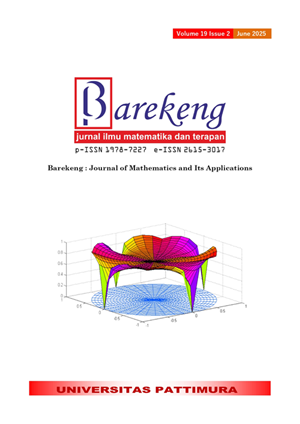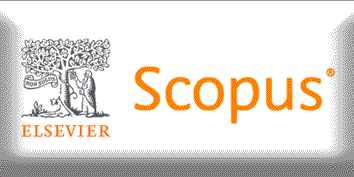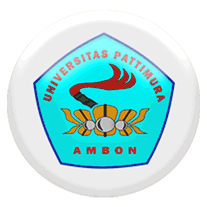THE COMPARISON OF EXTENDED AND ENSEMBLE KALMAN FILTERS IN MODELING ENVIRONMENTAL POLLUTION INFLUENCES ON ACUTE RESPIRATORY INFECTION DYNAMICS (ISPA)
Abstract
Acute Respiratory Infections (ISPA) are a significant health issue. According to the World Health Organization (WHO), ISPA is the leading cause of death among children under five worldwide. ISPA can be caused by environments with high levels of air pollution, particularly in urban areas. Predicting the spread of ISPA is a crucial step in controlling the disease. Since pollution sources are diverse, modeling and prediction can be difficult, which makes advanced methods such as the Kalman Filter (KF) desirable. This study compares two estimation methods, the Extended Kalman Filter (EKF) and the Ensemble Kalman Filter (EnKF), in predicting the spread of ISPA triggered by environmental pollution. Simulation results show that both methods can produce accurate estimations, but EnKF demonstrates superior performance in terms of RMSE compared to EKF. It predicts more accurately for susceptible (X) and infected (Y) populations with EnKF than with EKF. Based on the results of the EnKF for the X and Y populations, the RMSEs are 0.0660 and 0.1114, respectively. EnKF's advantage in handling uncertainty and non-linearity in the model makes it suitable for predicting the spread of ISPA.
Downloads
References
J. A. Davidson et al., “RISK OF ACUTE RESPIRATORY INFECTION AND ACUTE CARDIOVASCULAR EVENTS FOLLOWING ACUTE RESPIRATORY INFECTION AMONG ADULTS WITH INCREASED CARDIOVASCULAR RISK IN ENGLAND BETWEEN 2008 AND 2018: A RETROSPECTIVE, POPULATION-BASED COHORT STUDY.,” Lancet. Digit. Heal., vol. 3, no. 12, pp. e773–e783, Dec. 2021, doi: 10.1016/S2589-7500(21)00203-X.
B. Gobel, G. D. Kandou, and A. Asrifuddin, “FACTORS INFLUENCING THE INCIDENCE OF ARI IN TODDLERS IN EAST RATATOTOK VILLAGE,” J. KESMAS, vol. 10, no. 5, pp. 62–67, 2021.
A. G. Barnett et al., “AIR POLLUTION AND CHILD RESPIRATORY HEALTH: A CASE-CROSSOVER STUDY IN AUSTRALIA AND NEW ZEALAND,” Am. J. Respir. Crit. Care Med., vol. 171, no. 11, pp. 1272–1278, 2005, doi: 10.1164/rccm.200411-1586OC.
I. P. Wu, S. L. Liao, S. H. Lai, and K. S. Wong, “THE RESPIRATORY IMPACTS OF AIR POLLUTION IN CHILDREN: GLOBAL AND DOMESTIC (TAIWAN) SITUATION,” Biomed. J., vol. 45, no. 1, pp. 88–94, 2022, doi: 10.1016/j.bj.2021.12.004.
B. Afriani, “FACTORS ASSOCIATED WITH THE INCIDENCE OF ISPA IN TODDLERS,” Cendekia Med., vol. 5, no. 1, pp. 1–15, 2020, doi: 10.52235/cendekiamedika.v5i1.8.
Y. Kim and H. Bang, “INTRODUCTION TO KALMAN FILTER AND ITS APPLICATIONS,” in Introduction and Implementations of the Kalman Filter, IntechOpen, 2019. doi: 10.5772/intechopen.80600.
X. Lai, T. Yang, Z. Wang, and P. Chen, “IoT IMPLEMENTATION OF KALMAN FILTER TO IMPROVE ACCURACY OF AIR QUALITY MONITORING AND PREDICTION,” Appl. Sci., vol. 9, no. 9, May 2019, doi: 10.3390/app9091831.
D. J. Jwo and A. Biswal, “IMPLEMENTATION AND PERFORMANCE ANALYSIS OF KALMAN FILTERS WITH CONSISTENCY VALIDATION,” Mathematics, vol. 11, no. 3, Feb. 2023, doi: 10.3390/math11030521.
L. Meyer, D. Ichalal, and V. Vigneron, “AN UNKNOWN INPUT EXTENDED KALMAN FILTER FOR NONLINEAR STOCHASTIC SYSTEMS,” 2020.
A. N. A. Syarifudin, D. A. Merdekawati, and E. Apriliani, “COMPARISON OF KALMAN FILTER, EXTENDED KALMAN FILTER, AND ENSEMBLE KALMAN FILTER METHODS ON THE HIV/AIDS VIRUS SPREADING MODEL,” vol. 15, no. 1, pp. 17–29, 2018.
P. Kaniewski, “EXTENDED KALMAN FILTER WITH REDUCED COMPUTATIONAL DEMANDS FOR SYSTEMS WITH NON-LINEAR MEASUREMENT MODELS,” Sensors (Switzerland), vol. 20, no. 6, Mar. 2020, doi: 10.3390/s20061584.
T. K. S. Ritschel, D. Boiroux, M. K. Nielsen, J. K. Huusom, S. B. Jorgensen, and J. B. Jorgensen, “THE EXTENDED KALMAN FILTER FOR NONLINEAR STATE ESTIMATION IN A U-LOOP BIOREACTOR,” CCTA 2019 - 3rd IEEE Conf. Control Technol. Appl., pp. 920–925, 2019, doi: 10.1109/CCTA.2019.8920643.
M. Buehner, R. McTaggart-Cowan, and S. Heilliette, “AN ENSEMBLE KALMAN FILTER FOR NUMERICAL WEATHER PREDICTION BASED ON VARIATIONAL DATA ASSIMILATION: VarEnKF,” Mon. Weather Rev., vol. 145, no. 2, pp. 617–635, 2017, doi: 10.1175/MWR-D-16-0106.1.
T. Herlambang, H. Nurhadi, A. Muhith, D. Rahmalia, and B. P. Tomasouw, “ESTIMATION OF THIRD FINGER MOTION USING ENSEMBLE KALMAN FILTER,” BAREKENG J. Ilmu Mat. dan Terap., vol. 16, no. 3, pp. 1079–1086, 2022, doi: 10.30598/barekengvol16iss3pp1079-1086.
T. Herlambang, H. Nurhadi, F. A. Susanto, and B. P. Tomasouw, “COMPARISON OF H-INFINITY AND ENSEMBLE KALMAN FILTER FOR ESTIMATING MOTION OF MIDDLE FINGER,” BAREKENG J. Ilmu Mat. dan Terap., vol. 17, no. 4, pp. 2433–2442, 2023, doi: 10.30598/barekengvol17iss4pp2433-2442.
A. Sebbagh and S. Kechida, “EKF-SIRD MODEL ALGORITHM FOR PREDICTING THE CORONAVIRUS (COVID-19) SPREADING DYNAMICS,” Sci. Rep., vol. 12, no. 1, pp. 1–14, 2022, doi: 10.1038/s41598-022-16496-6.
P. Di Giamberardino and D. Iacoviello, “EARLY ESTIMATION OF THE NUMBER OF HIDDEN HIV INFECTED SUBJECTS: AN EXTENDED KALMAN FILTER APPROACH,” Infect. Dis. Model., vol. 8, no. 2, pp. 341–355, 2023, doi: 10.1016/j.idm.2023.03.001.
H. Liu, A. Thiboult, B. Tolson, F. Anctil, and J. Mai, “EFFICIENT TREATMENT OF CLIMATE DATA UNCERTAINTY IN ENSEMBLE KALMAN FILTER (ENKF) BASED ON AN EXISTING HISTORICAL CLIMATE ENSEMBLE DATASET,” J. Hydrol., vol. 568, pp. 985–996, Jan. 2019, doi: 10.1016/j.jhydrol.2018.11.047.
L. Mitchell and A. Arnold, “ANALYZING THE EFFECTS OF OBSERVATION FUNCTION SELECTION IN ENSEMBLE KALMAN FILTERING FOR EPIDEMIC MODELS,” Math. Biosci., vol. 339, pp. 1–29, 2021, doi: 10.1016/j.mbs.2021.108655.
R. Lal, W. Huang, and Z. Li, “AN APPLICATION OF THE ENSEMBLE KALMAN FILTER IN EPIDEMIOLOGICAL MODELLING,” PLoS One, vol. 16, no. 8 August, Aug. 2021, doi: 10.1371/journal.pone.0256227.
M. J. R. G. Sutopo and D. K. Arif, “ESTIMATION OF DENGUE FEVER DISEASE SPREAD MODEL USING ENSEMBLE KALMAN FILTER METHOD,” J. Sains dan Seni ITS, vol. 11, no. 2, pp. 2–7, 2022, doi: 10.12962/j23373520.v11i2.75581.
N. Kumari and S. Sharma, “MODELING THE DYNAMICS OF INFECTIOUS DISEASE UNDER THE INFLUENCE OF ENVIRONMENTAL POLLUTION,” Int. J. Appl. Comput. Math., vol. 4, no. 3, Jun. 2018, doi: 10.1007/s40819-018-0514-x.
S. Ungarala, “ON THE ITERATED FORMS OF KALMAN FILTERS USING STATISTICAL LINEARIZATION,” J. Process Control, vol. 22, no. 5, pp. 935–943, 2012, doi: 10.1016/j.jprocont.2012.03.004.
W. Wang and Y. Lu, “ANALYSIS OF THE MEAN ABSOLUTE ERROR (MAE) AND THE ROOT MEAN SQUARE ERROR (RMSE) IN ASSESSING ROUNDING MODEL,” in IOP Conference Series: Materials Science and Engineering, Institute of Physics Publishing, Apr. 2018. doi: 10.1088/1757-899X/324/1/012049.
Copyright (c) 2025 Yolanda Norasia, Dinni Rahma Oktaviani, Devi Marita Putri

This work is licensed under a Creative Commons Attribution-ShareAlike 4.0 International License.
Authors who publish with this Journal agree to the following terms:
- Author retain copyright and grant the journal right of first publication with the work simultaneously licensed under a creative commons attribution license that allow others to share the work within an acknowledgement of the work’s authorship and initial publication of this journal.
- Authors are able to enter into separate, additional contractual arrangement for the non-exclusive distribution of the journal’s published version of the work (e.g. acknowledgement of its initial publication in this journal).
- Authors are permitted and encouraged to post their work online (e.g. in institutional repositories or on their websites) prior to and during the submission process, as it can lead to productive exchanges, as well as earlier and greater citation of published works.






1.gif)



